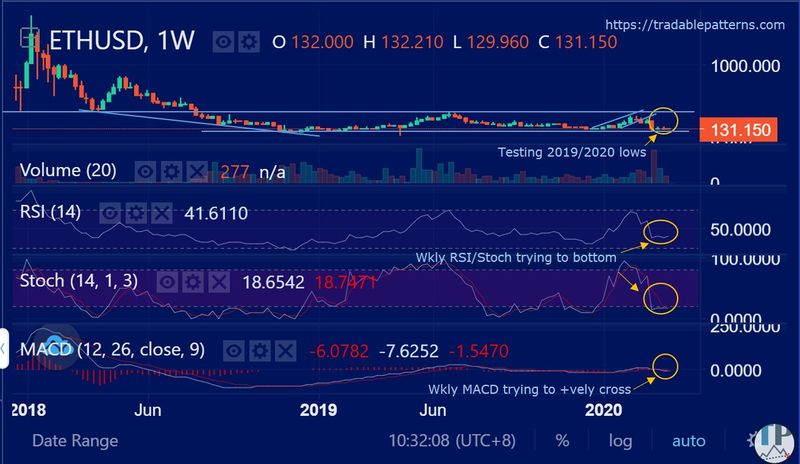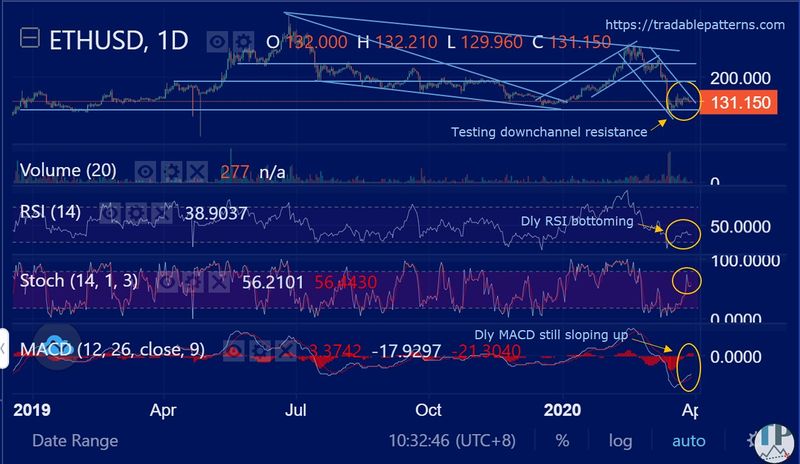
Mar 29, 2020 - Posted by Darren Chu, CFA of Tradable Patterns
Ethereum (ETHUSD) continued this past week trying to firm after the first half of March plunge brought ETHUSD to around the 2019 low. Significantly, ETHUSD has reclaimed last November/December’s low, and is testing a month plus downchannel resistance (on the daily chart). Any decisive surge above the daily chart downchannel resistance could see ETHUSD retest the psychologically key 200 whole figure level in the next month or so. The weekly RSI and Stochastics are in the early stage of trying to bottom, and appear poised to follow the weekly MACD, and daily RSI, Stochastics and MACD in their bottomish patterns. Note that the two spikes lower (on the daily chart) in April 2019 are specific to the Liquid ETHUSD market, due to insufficient liquidity, marketmaker and circuitbreaker support (specifically on this exchange market) and not a spike move down on ETHUSD (across other exchange markets).
Ethereum (ETHUSD) Weekly/Daily/4hr
Credit to: Copyright © 2020 Tradable Patterns Limited, All rights reserved.
Ethereum Fundamentals
The Ethereum hard fork Muir Glacier completed January 2nd, 2020, addressing the “Ice Age difficulty bomb” ahead of a fork planned for Q2 2020 named Berlin. Muir Glacier occurred just 3 weeks after Ethereum’s Dec 8th hard fork Istanbul, which introduced privacy improvements and altered gas pricing. Ethereum Version 2.0 follows Berlin, moving Ethereum from the Proof of Work algorithm for validating transactions to Proof of Stake, making transactions faster and cheaper. Other scalability improvements including Sharding and possibly Layer 2 solutions like Plasma and Raiden are scheduled for 2020. Meanwhile, Ethereum developers have their work cut out for them as debate rages among developers and miners on mining difficulty and incentives, while newer blockchain competitors built for greater scalability attract more developers and funding. Although Ethereum is often portrayed as being highly decentralized, it should be remembered that Ethereum’s network is increasingly vulnerable as more than 60% of its nodes are now hosted within cloud networks like Amazon’s AWS, Google Cloud and Alibaba Cloud. Any decision by these Big Techs to push a competing cryptocurrency/blockchain could sideline these Ethereum nodes.
LedgerX and ErisX continue preparing to launch physically delivered Ethereum futures, with the CME appearing to be laying the ground work to follow suit, as it finetunes its Ethereum reference rate and index.
Industry Fundamentals
Tencent announced just before Xmas that it is forming a cryptocurrency research unit, likely assisting with the China digital Renminbi coin launch. Tencent-operated WeChat Pay has a 40% market share in China’s mobile payments industry, and 900 million users globally as of 2017 (with the majority in China as WeChat Pay is available only in a few countries outside of China)…
Click hereto read the rest of the Industry Fundamentals, along with technical and fundamental analysis of Bitcoin and Ripple
About the author: Before the launch of Tradable Patterns, Darren Chu, CFA, served as IntercontinentalExchange | NYSE Liffe’s country manager for Australia, India, and the UAE between July 2010 and January 2014, expanding his role to look after Liffe business development in APAC ex-Japan/Korea until his departure mid April 2014. His primary remit was developing relationships with Liffe clients, prospects and partners in the buyside (traditional and alternative asset managers), proprietary trading (high frequency algo as well as manual, point and click traders), bank, broker (institutional and retail), commodity trader and ISV community. Key futures and options promoted included European/London rate benchmarks such as the Euribor, Short Sterling, Gilts, London/European index futures including the FTSE and CAC, London soft commodities (Robusta Coffee, Cocoa, White Sugar), Paris (MATIF) markets (Milling Wheat, Rapeseed), and NYSE Liffe US markets with the MSCI EM, MSCI EAFE, gold/silver, Eurodollar, US Treasury and GCF Repo futures being the focus.
Previously, Darren was with the TMX Group | Montreal Exchange for 4 years, marketing Canadian futures and options across North America, London, Singapore and Hong Kong. Darren also launched and managed CMC Markets Canada’s Chinese marketing and sales team, along with educational offering. On the academic trail, Darren has been a frequent guest speaker at Canadian universities as well as an author of content for 3 derivatives courses offered by Canadian Securities Institute and mandatory for licensing of Canadian derivatives industry professionals.
Darren can be reached at: +65 8118 8840 or via email at darrenchu@tradablepatterns.com.
Mar 29, 2020 - Posted by Darren Chu, CFA of Tradable Patterns
Ethereum (ETHUSD) continued this past week trying to firm after the first half of March plunge brought ETHUSD to around the 2019 low. Significantly, ETHUSD has reclaimed last November/December’s low, and is testing a month plus downchannel resistance (on the daily chart). Any decisive surge above the daily chart downchannel resistance could see ETHUSD retest the psychologically key 200 whole figure level in the next month or so. The weekly RSI and Stochastics are in the early stage of trying to bottom, and appear poised to follow the weekly MACD, and daily RSI, Stochastics and MACD in their bottomish patterns. Note that the two spikes lower (on the daily chart) in April 2019 are specific to the Liquid ETHUSD market, due to insufficient liquidity, marketmaker and circuitbreaker support (specifically on this exchange market) and not a spike move down on ETHUSD (across other exchange markets).
Ethereum (ETHUSD) Weekly/Daily/4hr
Credit to: Copyright © 2020 Tradable Patterns Limited, All rights reserved.
Ethereum Fundamentals
The Ethereum hard fork Muir Glacier completed January 2nd, 2020, addressing the “Ice Age difficulty bomb” ahead of a fork planned for Q2 2020 named Berlin. Muir Glacier occurred just 3 weeks after Ethereum’s Dec 8th hard fork Istanbul, which introduced privacy improvements and altered gas pricing. Ethereum Version 2.0 follows Berlin, moving Ethereum from the Proof of Work algorithm for validating transactions to Proof of Stake, making transactions faster and cheaper. Other scalability improvements including Sharding and possibly Layer 2 solutions like Plasma and Raiden are scheduled for 2020. Meanwhile, Ethereum developers have their work cut out for them as debate rages among developers and miners on mining difficulty and incentives, while newer blockchain competitors built for greater scalability attract more developers and funding. Although Ethereum is often portrayed as being highly decentralized, it should be remembered that Ethereum’s network is increasingly vulnerable as more than 60% of its nodes are now hosted within cloud networks like Amazon’s AWS, Google Cloud and Alibaba Cloud. Any decision by these Big Techs to push a competing cryptocurrency/blockchain could sideline these Ethereum nodes.
LedgerX and ErisX continue preparing to launch physically delivered Ethereum futures, with the CME appearing to be laying the ground work to follow suit, as it finetunes its Ethereum reference rate and index.
Industry Fundamentals
Tencent announced just before Xmas that it is forming a cryptocurrency research unit, likely assisting with the China digital Renminbi coin launch. Tencent-operated WeChat Pay has a 40% market share in China’s mobile payments industry, and 900 million users globally as of 2017 (with the majority in China as WeChat Pay is available only in a few countries outside of China)…
Click hereto read the rest of the Industry Fundamentals, along with technical and fundamental analysis of Bitcoin and Ripple
About the author: Before the launch of Tradable Patterns, Darren Chu, CFA, served as IntercontinentalExchange | NYSE Liffe’s country manager for Australia, India, and the UAE between July 2010 and January 2014, expanding his role to look after Liffe business development in APAC ex-Japan/Korea until his departure mid April 2014. His primary remit was developing relationships with Liffe clients, prospects and partners in the buyside (traditional and alternative asset managers), proprietary trading (high frequency algo as well as manual, point and click traders), bank, broker (institutional and retail), commodity trader and ISV community. Key futures and options promoted included European/London rate benchmarks such as the Euribor, Short Sterling, Gilts, London/European index futures including the FTSE and CAC, London soft commodities (Robusta Coffee, Cocoa, White Sugar), Paris (MATIF) markets (Milling Wheat, Rapeseed), and NYSE Liffe US markets with the MSCI EM, MSCI EAFE, gold/silver, Eurodollar, US Treasury and GCF Repo futures being the focus.
Previously, Darren was with the TMX Group | Montreal Exchange for 4 years, marketing Canadian futures and options across North America, London, Singapore and Hong Kong. Darren also launched and managed CMC Markets Canada’s Chinese marketing and sales team, along with educational offering. On the academic trail, Darren has been a frequent guest speaker at Canadian universities as well as an author of content for 3 derivatives courses offered by Canadian Securities Institute and mandatory for licensing of Canadian derivatives industry professionals.
Darren can be reached at: +65 8118 8840 or via email at darrenchu@tradablepatterns.com.


